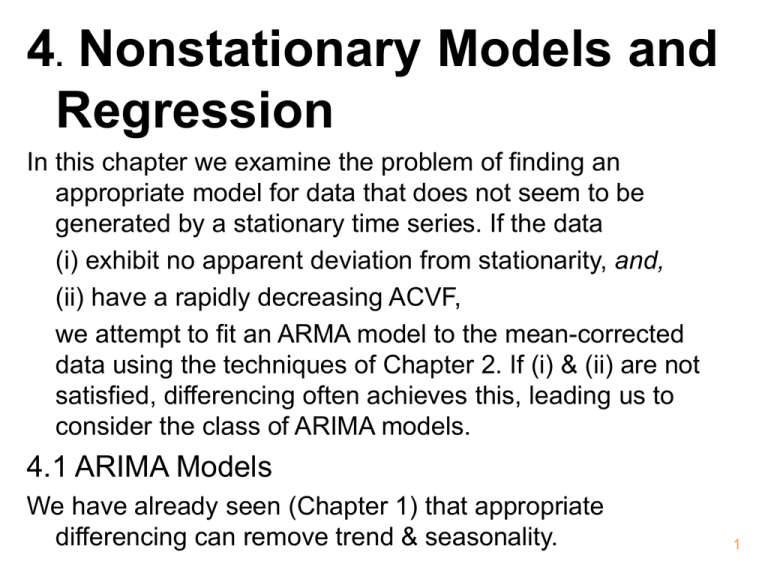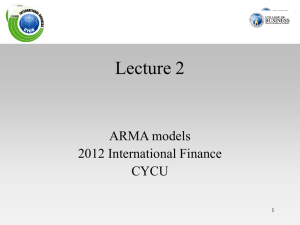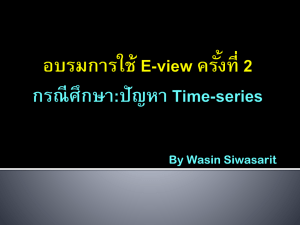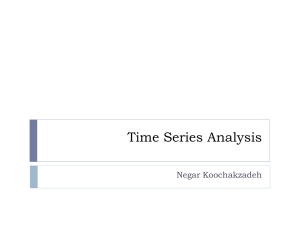Applied Time Series Analysis
advertisement

4. Nonstationary Models and
Regression
In this chapter we examine the problem of finding an
appropriate model for data that does not seem to be
generated by a stationary time series. If the data
(i) exhibit no apparent deviation from stationarity, and,
(ii) have a rapidly decreasing ACVF,
we attempt to fit an ARMA model to the mean-corrected
data using the techniques of Chapter 2. If (i) & (ii) are not
satisfied, differencing often achieves this, leading us to
consider the class of ARIMA models.
4.1 ARIMA Models
We have already seen (Chapter 1) that appropriate
differencing can remove trend & seasonality.
1
The AutoRegressive Integrated Moving Average (ARIMA)
model, is a broadening of the class of ARMA models to
include differencing. A process {Xt} is said to be an
ARIMA(p,d,q) if {(1-B)d Xt } is a causal ARMA(p,q). We
write the model as:
f(B)(1-B)d Xt = q(B) Zt,
{Zt} WN(0,2),
The process is stationary if and only if d=0. Differencing Xt
d times, results in an ARMA(p,q) with f(B) and q(B) as AR &
MA polynomials.
Recall from Chapter 1 that differencing a polynomial of degree
d-1, d times, will reduce it to zero. We can therefore add an
arbitrary poly of degree d-1 to {Xt} without violating the
above difference equation. This means that ARIMA’s are
useful for representing data with trend. In fact, in many
situations it is appropriate to think of time series as being
made up of two components: a nonstationary trend, and a
zero-mean stationary component. Differencing such a
2
process will result in a stationary process.
Ex: ARIMA.TSM contains 200 obs from the ARIMA(1,1,0)
(1-0.8B)(1-B) Xt = Zt,
{Zt} WN(0,1).
Series
90.
80.
70.
60.
50.
40.
30.
20.
10.
0.
0
40
80
120
Sample A CF
1.00
160
Sample PA CF
1.00
.80
.80
.60
.60
.40
.40
.20
.20
.00
.00
-.20
-.20
-.40
-.40
-.60
-.60
-.80
-.80
-1.00
200
-1.00
0
5
10
15
20
25
30
35
40
0
5
10
15
20
25
30
35
40
3
The slowly decaying ACF of the series in previous example, is
characteristic of ARIMA’s. When searching for a model to fit
to such data therefore, we would proceed by applying the
operator (1-B) repeatedly, in the hope that for some d,
(1-B)d Xt will have a rapidly decaying ACF compatible with
that of an ARMA process. (Do not overdifference however,
as this can introduce dependence where none existed
before. Ex: Xt=Zt, is WN, but (1-B)Xt=Zt-Zt-1, an MA(1)!)
Ex: Apply (1-B)Xt to ARIMA.TSM, get ML model:
(1 - 0.787 B)(1-B) Xt = Zt, {Zt} WN(0,1.012).
Now fit min AICC AR model via ML to undifferenced data:
(1 - 0.802 B)(1 - 0.985 B) Xt = Zt, {Zt} WN(0,1.010).
Note the closeness in the coefficients between the two
models. The second model is just barely stationary, and it is
very difficult to distinguish between realizations of these
two. In general it is better to fit an ARIMA to nonstationary
4
looking data. The coefficients in the residual ARMA tend to
be further from 1. Their estimation is therefore more stable.
Forecasting ARIMA’s
The defining difference equations for an ARIMA(p,d,q) are not
sufficient to determine best linear predictors for Xt. If we
denote the residual ARMA model by Yt, that is,
(1-B)d Xt = Yt, for t=1,2,…
then, under the assumption that (Xt-d,…, X0) is
uncorrelated with Yt, t>0, the best linear predictor of Xn+h
based on the obs X1,…, Xn can be calculated recursively
similarly to the ARMA case, as:
Pn X n h = i =1 f P X n h-i j =h q n h-1, j X nh- j - Pn h- j -1 X n h- j .
pd
*
i n
q
As before, the {qj,i} are obtained via the Innovations
Algorithm, and the {fi*} are the coefficients in the
transformed AR polynomial, f*(z)=(1-z)d f(z). Similar results
hold for the MSE.
5
Summary of ARMA/ARIMA modeling procedures
1. Perform preliminary transformations (if necessary) to
stabilize variance over time. This can often be achieved
by the Box-Cox transformation:
fl(Xt) = (Xtl - 1/l, if Xt0, and l>0,
fl(Xt) = log (Xt,
if Xt>0, and l=0.
In practice, l=0 or l=0.5 are often adequate.
2. Detrend and deseasonalize the data (if necessary) to
make the stationarity assumption look reasonable. (Trend
and seasonality are also characterized by ACF’s that are
slowly decaying and nearly periodic, respectively). The
primary methods for achieving this are classical
decomposition, and differencing (Chapter 2).
3. If the data looks nonstationary without a well-defined
trend or seasonality, an alternative to the above option is
to difference successively (at lag 1). (This may also
need to be done after the above step anyway).
6
Examine sample ACF & PACF to get an idea of potential
p & q values. For an AR(p)/MA(q), the sample PACF/ACF
cuts off after lag p/q.
5. Obtain preliminary estimates of the coefficients for select
values of p & q. For q=0, use Burg; for p=0 use
Innovations; and for p0 & q0 use Hannan-Rissanen.
6. Starting from the preliminary estimates, obtain maximum
likelihood estimates of the coefficients for the promising
models found in step 5.
7. From the fitted ML models above, choose the one with
smallest AICC, taking into consideration also other
candidate models whose AICC is close to the minimum
(within about 2 units). The minimization of the AICC must
be done one model at a time, but this search can be
carried out systematically by examining all the pairs (p,q)
such that p+q=1, 2, … , in turn. (A quicker but rougher
method: run through ARMA(p,p)’s, as p=1,2,…, in turn.) 7
4.
8. Can bypass steps 4-7 by using the option Autofit. This
automatically searches for the minimum AICC ARMA(p,q)
model (based on ML estimates), for all values of p and q in
the user-specified range. Drawbacks:
a) can take a long time, and
b) initial estimates for all parameters are set at 0.001.
The resulting model should be checked via prelim. est.
followed by ML est. to guard against the possibility of being
trapped in a local maximum of the likelihood surface.
9. Inspection of the standard errors of the coefficients at the
ML estimation stage, may reveal that some of them are not
significant. If so, subset models can be fitted by
constraining these to be zero at a second iteration of ML
estimation. Use a cutoff of between 1 (more conservative,
use when few parameters in model) and 2 (less
conservative) standard errors when assessing significance.
8
10. Check the candidate models for goodness-of-fit by
examining their residuals. This involves inspecting their
ACF/PACF for departures from WN, and by carrying out
the formal WN hypothesis tests (Section 2.4).
Examples:
1) LAKE.TSM
Min AICC Burg AR model has p=2, min AICC IA MA model
has q=7, min AICC H-R ARMA(p,p) model has p=1.
Starting from these 3 models, we obtain ML estimates, and
find that the ARMA(1,1) model:
Xt - 0.74 Xt-1 = Zt 0.32 Zt-1, {Zt} WN(0,0.48),
has the smallest AICC.
9
2) WINE.TSM
Take logs and difference at lag 12.
Min AICC Burg AR model has p=12.
ML estimation leads to AR(12) with AICC=-158.9.
Coefficients of lags 2,3,4,6,7,9,10,11 are not sig.
Constrained ML leads to a subset AR(12) with AICC=172.5.
Min AICC IA MA model has q=13. After ML estimation,
coefficients of lags 4,6,11 are not sig. Constrained ML leads
to a subset MA(13) with AICC=-178.3.
Using Autofit with max p=15=max q, gives ARMA(1,12). Get
H-R estimates, follow up with constrained MLE by setting
coeffts of lags 1,3,4,6,7,9,11 to zero.
Resulting subset model has AICC=-184.1.
All 3 models pass WN tests. Choose last since it has
smallest AICC.
10
4.2 SARIMA Models
Often the dependence on the past tends to occur most
strongly at multiples of some underlying seasonal lag s.
E.g. monthly (quarterly) economic data usually show a
strong yearly component occurring at lags that are multiples
of s=12 (s=4). Seasonal ARIMA (SARIMA) models are
extensions of the ARIMA model to account for the seasonal
nonstationary behavior of some series.
The process {Xt} is a SARIMA(p,d,q)(P,D,Q)s with period s,
if the differenced series Yt=1-Bd1-BsDXt is a causal
ARMA process defined by:
f(B)F(Bs) Yt = q(B)Q(Bs) Zt, {Zt} WN(0,2),
where f(B) and F(B) are different AR polynomials of orders
p and P, respectively; and q(B) and Q(B) are different MA
polynomials of orders q and Q, respectively.
The idea here is to try to model the seasonal behavior via the
11
ARMA, F(Bs)Yt = Q(Bs)Zt, and the nonseasonal component
via the ARMA, f(B)Yt = q(B)Zt. These two are then
combined multiplicatively as in the definition. The
preliminary differencing on Xt to produce Yt, will take care of
any seasonal nonstationarity that may occur, e.g. when the
process is nearly periodic in the season.
SARIMA Modeling Guidelines:
With knowledge of s, select appropriate values of d and D
in order to make Yt=1-Bd1-BsDXt appear stationary. (D is
rarely more than 1.)
Choose P & Q so that ˆ (hs), h=1,2,…, is compatible with
the ACF of an ARMA(P,Q). (P & Q typically less than 3.)
Choose p & q so that ˆ 1,, ˆ s - 1 is compatible with
the ACF of an ARMA(p,q).
Choice from among the competing models should be based
on AICC and goodness of fit tests.
12
A more direct approach/alternative to modeling the differenced
series {Yt}, is to simply fit a subset ARMA to it without
making use of the SARIMA multiplicative structure.
The forecasting of SARIMA processes is completely
analogous to that of ARIMA’s.
Ex: (DEATHS.TSM)
Form Yt=1-B1-B12Xt to obtain a stationary-looking series
(s=12, d=D=1).
ˆ 12,
ˆ 24,
ˆ 36,, suggest an MA(1)
The values
(or AR(1)) for the between-year model i.e. P=0, Q=1.
Inspection of ˆ 1,, ˆ 11, suggests also an MA(1) (or
AR(1)) for the between-month model i.e. p=0, q=1.
Our (mean-corrected) proposed model for Yt is therefore
Yt = 1 q1B1 + Q1B12 Zt. Based on ˆ 1 andˆ 12, we
make the initial guesses: q1 =- 0.3, Q1=-0.3. This means
that our preliminary model is the MA(13):
13
Yt = 1 - 0.3B1 - 0.3B12 Zt = Zt - 0.3Zt-1 - 0.3Zt-12 0.09Zt-13.
Preliminary estimation algorithms don’t allow subset models.)
Now choose “constrain optimization” in the MLE window,
and select 1 in the “specify multiplicative relations” box.
Enter 1, 12, 13 to indicate that q1 q12 = q13.
Final model has AICC=855.5, and {Zt} WN(0,94251):
Yt = 28.83 Zt - 0.479Zt-1 - 0.591Zt-12 0.283Zt-13.
If we fit instead a subset MA(13) model without seeking a
multiplicative structure, we note that the coefficients of lags
2, 3, 8, 10, and 11 are not sig. Running constrained MLE,
we now find that the coefficients of lags 4, 5, and 7 are
promising candidates to set to zero. Re-running constrained
MLE, we finally find that the coefficient of lag 9 is not sig.
Constrained MLE once more gives model with AICC=855.6,
and {Zt} WN(0,71278):
Yt = 28.83 Zt - 0.596Zt-1 - 0.406Zt-6 - 0.686Zt-12 0.459Zt-13.
14
Predict next 6 obs.
4.3 Regression with ARMA Errors
In this section, we will consider a generalization of the
standard linear regression model, that allows for correlated
errors. The general model takes the form,
Yt = b1Xt1 bkXtk Wt, t=1,, n,
or, Y = X b W, where:
Y = Y1, ,Yn)T, is the vector of responses (or time series
observations).
X is the design matrix consisting of the n vectors of
explanatory variables (covariates), Xt = Xt1, ,Xtk)T.
b = b1, , bk)T, is the vector of regression parameters.
W = W1, ,Wn)T, is the error vector consisting of obs from
the zero-mean ARMA(p,q) model:
15
f(B) Wt = q(B) Zt, {Zt} WN(0,2).
(Note that in standard regression, {Wt} WN(0,2).)
We have already seen one application of this model for
estimating trend. For example, in a model with quadratic
trend, we would set Xt1=1, Xt2= t, and Xt3= t2, to give
Yt = b1 b2 t b3 t2 Wt.
In this example, each Xtj is a function of t only, but in the
general case they will be any covariates observed
contemporaneously with the response that are thought to
explain some of its variability. Examples might be
meteorological variables, chemical levels, socioeconomic
factors, etc.
Now, the Ordinary Least Squares Estimator (OLSE) of b is
{
bˆOLS = arg min Y - Xb T Y - Xb = X T X X T Y
-1
which coincides with the MLE if {Wt} IID N(0,2). (Take
any g-inverse in above; estimator unique if XTX )
nonsingular.)
16
The OLSE is also the Best (smallest variance) Linear
Unbiased E bˆ = b Estimator (BLUE) in the case of
uncorrelated errors (this is the Gauss-Markov Theorem). In
the case when {Wt} follows an ARMA(p,q), the OLSE is
linear and unbiased, but no longer the best estimator. The
BLUE of b in this case, is the Generalized Least Squares
Estimator (GLSE):
bˆGLS = argmin Y - Xb T Gn-1 Y - Xb
{
= X T Gn-1 X
-1
X T Gn-1Y
where Gn is the covariance matrix of W, i.e. Gn =E(WWT).
(For a given Gn, bˆGLS is also the MLE of b if W is Gaussian.)
If the ARMA parameters {f, q, 2 were known, it would
therefore be straightforward to obtain bˆGLS by maximizing
the Gaussian likelihood of the process
Wt = Yt - bTxt,
t=1, ,n.
17
In practice however, we don’t know {f, q, 2, so the entire set
of parameters, {b, f, q, 2 (as well as the order p & q), will
have to be simultaneously estimated from the data. We can
do this by minimizing the (reduced) likelihood L bˆ ,fˆ,qˆ
simultaneously for {b, f, q, (2 can be profiled out of the
likelihood equations, hence the name reduced likelihood),
to obtain bˆGLS fˆ,qˆ .
This suggests the following procedure for estimating the
parameters of a time series regression with ARMA errors:
Step 0
-1
0
T
ˆ
ˆ
(i) Set b = b OLS = X X X T Y
0
0 T
ˆ
X t , t = 1,, n.
(ii) Obtain the residuals Wt = Yt - b
(iii) Identify the order p & q of the ARMA model to fit to {Wt0},
0
ˆ
f
and obtain the MLE’s
and qˆ 0 .
18
Step 1
-1
1
0 ˆ 0
T
-1
T
-1
ˆ
ˆ
ˆ
b
=
b
f
,
q
=
X
G
X
X
G
(i) Set
GLS
n
n Y.
(ii) Obtain the residuals Wt 1 = Yt - bˆ 1T X t , t = 1,, n.
1
(iii) Obtain the MLE’s fˆ and qˆ 1 based on {Wt1}.
Step j, j2
-1
j
j -1 ˆ j -1
T -1
ˆ
ˆ
ˆ
,q
= X Gn X X T Gn-1Y .
(i) Set b = b GLS f
(ii) Obtain the residuals Wt j = Yt - bˆ j T X t , t = 1,, n.
(iii) Obtain the MLE’s fˆ j and qˆ j based on {Wtj}.
...
STOP when there’s no change in bˆ from the previous step.
(Usually 2 or 3 iterations suffice.)
Example: The lake data (LAKE.TSM)
Let us investigate if there’s evidence of a decline in the level
of lake Huron over the years 1875-1972.
19
We will fit the linear regression model Yt = b1 b2 t Wt.
Steps in ITSM2000:
Regression > Specify > Polynomial Regression >
Order=1.
GLS button > MLE button. Regression estimates
window gives the OLS estimates (std. errors), bˆ1 =10.202
(.2278), and bˆ2 =-0.024 (.0040), with the ML WN(0,1.251)
model for the residuals {Wt}.
Sample ACF/PACF button suggests an AR(2) model for
the residuals {Wt}. (The data now become estimates of
{Wt}. )
Preliminary estimation button > AR(2) > Burg, gives the
estimated Burg model for {Wt}.
MLE button gives the ML model for {Wt} and the updated
bˆ in the regression estimates window.
MLE button several times gives convergence to the final
model in regression estimates window:
Yt = 10.091 - 0.022 t 1.004Wt-1- 0.290Wt-2 Zt,
{Zt} WN(0,0.457).
20
A 95% CI for b2 is: -0.0221.960.0081=-0.038, -0.006; a
significant decrease in lake Huron levels. Note the change
in the std. errors of bˆ from OLS, highlighting the importance
of taking into account the correlation in the residuals.) Show
fit!
Example: Seat-belt data (SBL.TSM, SBLIN.TSM)
SBL.TSM contains the numbers of monthly serious injuries, Yt,
t=1,…,120, on UK roads for 10 years starting Jan ’75. In the
hope of reducing these numbers, seat-belt legislation was
introduced in Feb ’83 (t ≥ 99). To study if there was a
significant mean drop in injuries from that time onwards, we
fit the regression model:
Yt = b1 b2ft Wt, t=1,…,120.
where ft=0, 1 ≤ t ≤ 98, and ft=1, t ≥ 99 (file SBLIN.TSM).
Steps in ITSM2000:
Regression > Specify > Poly Regression, order 0 >
Include Auxiliary Variables Imported from File >
SBLIN.TSM.
21
GLS button > MLE button. Regression estimates
window gives the OLS estimates (std. errors), bˆ1 =1621.1
(22.64), and bˆ2 =-299.5 (51.71).
Graph of data (now the estimate of {Wt}) and ACF/PACF
plots, clearly suggests a strong seasonal component with
period 12. We therefore difference the original data at lag
12, and consider instead the model:
Xt = b2gt Nt, t=13,…,120.
where Xt= Yt-Yt-12 (file SBLD.TSM), gt=ft-ft-12 (file
SBLDIN.TSM), and Nt=Wt – Wt-12, is a stationary sequence
to be represented by a suitable ARMA process.
Open SBLD.TSM > Regression > Specify > Include
Auxiliary Variables Imported from File (no Poly
Regression, no Intercept) > SBLDIN.TSM.
GLS > MLE. Sample ACF/PACF button suggests an
AR(13) or MA(13) model for the residuals {Nt}. Autofit
option with max lag 13 for both AR & MA finds MA(12) to be
best.
22
Fitting MA(12) model via Preliminary estimation button >
MA(12) > Innovations, gives the estimated Innovations
Algorithm model for Nt.
MLE button gives the ML model for Nt and the updated
in the regression estimates window.
MLE button several times gives convergence to the final
model in the regression estimates window,
Xt = -325.2 gt Nt ,
with
Nt = Zt 0.213 Zt-1 - 0.633 Zt-12 , {Zt} WN(0,12,572).
Standard error of bˆ2 is 48.5, so -325.2 is very significantly
negative, indicating the effectiveness of the legislation.
Show fit!
23
5. Forecasting Techniques
So far we have focused on the construction of time series
models for both stationary and nonstationary data, and the
calculation of minimum MSE predictors based on these
models. In this chapter we discuss 3 forecasting techniques
that have less emphasis on the explicit construction of a
model for the data. These techniques have been found in
practice to be effective on a wide range of real data sets.
5.1 The ARAR Algorithm
This algorithm has two steps:
1) Memory Shortening.
Reduces the data to a series which can reasonably be
modeled as an ARMA process.
2) Fitting a Subset Autoregression.
Fits a subset AR model with lags {1,k1,k2,k3},
24
1<k1<k2<k3m (m can be either 13 or 26), to the memory
shortened data. The lags {k1,k2,k3} and corresponding
model parameters are estimated either by minimizing 2, or
maximizing the Gaussian likelihood.
Stationary
White
Data
Memory
Series
Noise
Shortening
SAR filter
{Yt}
{St}
{Zt}
Minimum MSE forecasts can then be computed based on
the fitted models.
Ex: (DEATHS.TSM). Forecasting > ARAR. Forecast next 6
months using m=13 (minimize WN variance). Info window
gives details.
25
5.2 The Holt-Winters (HW) Algorithm
This algorithm is primarily suited for series that have a locally
linear trend but no seasonality. The basic idea is to allow for
a time-varying trend by specifying the forecasts to have the
form:
PtYt h = aˆt bˆt h, h = 1,2,3,...
where,
aˆ t is the estimated level at time t, and
bˆt is the estimated slope at time t.
Like exponential smoothing, we now take the estimated level
at time t+1 to be a weighted average of the observed and
forecast values, i.e.
aˆt 1 = Yt 1 (1- )PtYt 1 = Yt 1 (1- )(aˆt bˆt ).
Similarly, the estimated slope at time t+1 is given by,
bˆt 1 = b (aˆt 1 - aˆt ) (1 - b )bˆt .
26
With the natural initial conditions,
bˆ2 = Y2 - Y1,
aˆ2 = Y2, and
and by choosing and b to minimize the sum of squares of
the one-step prediction errors,
n
t =3 (Yt - Pt-1Yt)2,
the recursions for aˆ t and bˆt can be solved for t=2,…,n.
The forecasts then have the form:
PnYnh = aˆn bˆn h, h = 1,2,3,....
Ex: DEATHS.TSM
Forecasting > Holt-Winters. Forecast next 6
months. Info window gives details.
27
5.3 The Seasonal Holt-Winters (SHW) Algorithm
It’s clear from the previous example that the HW Algorithm
does not handle series with seasonality very well. If we
know the period (d) of our series, HW can be modified to
take this into account. In this seasonal version of HW, the
forecast function is modified to:
PtYt h = aˆt bˆt h cˆt h , h = 1,2,3,...
ˆ t and bˆt are as before, and cˆt is the estimated
where a
seasonal component at time t.
With the same recursions for bˆt as in HW, we modify the
ˆ t according to,
recursion for a
aˆt 1 = (Yt 1 - cˆt 1-d ) (1 - )(aˆt bˆt ),
and add the additional recursion for cˆt ,
cˆt 1 = (Yt 1 - aˆt 1 ) (1 - )cˆt 1-d .
28
Analogous to HW, natural initial conditions hold to start off the
recursions, and the smoothing parameters {,b,, are once
again chosen to minimize the sum of squares of the onestep prediction errors. The forecasts then have the form:
PnYnh = aˆn bˆn h cˆnh , h = 1,2,3,...
Ex: (DEATHS.TSM). Forecasting > Seasonal Holt-Winters.
Forecast next 6 months. Info window gives details.
29
5.4 Choosing a Forecasting Algorithm
This is a difficult question! Real data does not follow any
model, so smallest MSE forecasts may not in fact have
smallest MSE.
Some general advice can however be given. First identify
what measure of forecast error is most appropriate for the
particular situation at hand. One can use mean squared
error, mean absolute error, one-step error, 12-step error,
etc. Assuming enough (historical) data is available, we can
then proceed as follows:
Omit the last k observations from the series, to obtain a
reduced data set called the training set.
Use a variety of algorithms and forecasting techniques to
predict the next k obs for the training set.
30
Now compare the predictions to the actual realized values
(the test set), using an appropriate criterion such as root
mean squared error (RMSE)
{
(Y
- PnYn h )
.
RMSE =
k h =1 n h
Use the forecasting technique/algorithm that gave the
smallest value of RMSE for the test set, and use it on the
original data set (training+test set) to obtain the desired outof-sample forecasts.
Multivariate methods can also be considered, (Chapters 5 and
6).
1
k
2
1/ 2
Ex: (DEATHS.TSM). The file DEATHSF.TSM contains the
original series plus the next 6 realized values Y73,…,Y78.
Using DEATHS.TSM, we obtain P72Y73,…,P72Y78 via each
of the following methods (and compute corresponding
RMSE’s):
31
Forecasting Method
HW
SARIMA model from 4.2
Subset MA(13) from 4.2
SHW
ARAR
RMSE
1143
583
501
401
253
(The 6 realized values of the series, Y73,…,Y78, are:
7798, 7406, 8363, 8460, 9217, 9316.)
The ARAR algorithm does substantially better than
the others for this data.
32
5.5 Forecast Monitoring
If the original model fitted to the series up to time n is to be used
for ongoing prediction as new data comes in, it may prove
useful to monitor the one-step forecast errors for evidence
that this model is no longer appropriate. That is, for
t=n+1,n+2,…, we monitor the series:
Zˆt = X t - Xˆ t = X t - Pt -1 X t
As long as the original model is still appropriate, the series {Zˆt }
should exhibit the characteristics of a WN sequence. Thus
one can monitor the sample ACF and PACF of this
developing series for signs of trouble, i.e. autocorrelation.
Example: Observations for t=1,…,100 were simulated from an
MA(1) model with q=0.9. Consider what happens in the
following two scenarios corresponding to the arrival of new
data for t=101,…,200, stemming from two different models.
33
Case 1: New data continues to follow the same MA(1) model
34
Case 2: New data switches to an AR(1) model with f=0.9
35
7. Nonlinear Models
The stationary models so far covered in this course are linear
In nature, that is they can be expressed as,
X t = j =0 j Z t - j , {Z t } ~ IID (0, 2 ),
usually with {Zt} Gaussian. (Xt is then a Gaussian linear
process). Such processes have a number of properties that
are often found to be violated by observed time series:
Time-irreversibility. In a Gaussian linear process,
(Xt,…,Xt+h) has the same distribution as (Xt+h,…,Xt), for any
h>0 (obs not necessarily equally spaced). Deviations from
the time-reversibility property in observed time series are
suggested by sample paths that rise to their maxima and fall
away at different rates.
36
Ex: SUNSPOTS.TSM.
Bursts of outlying values are frequently observed in
practical time series, and are seen also in the sample paths
of nonlinear models. They are rarely seen in the sample
paths of Gaussian linear processes.
Ex: E1032.TSM. Daily % returns of Dow Jones Industrial
Index from 7/1/97 to 4/9/99.
Changing volatility. Many observed time series,
particularly financial ones, exhibit periods during which they
are less predictable or more variable (volatile), depending
on their past history. This dependence of predictability on
past history cannot be modeled with a linear time series,
since the minimum h-step MSE is independent of the past.
The ARCH and GARCH nonlinear models we are about to
consider, do take into account the possibility that certain
past histories may permit more accurate forecasting than
others, and can identify the circumstances under which this
37
can be expected to occur.
7.1 Distinguishing Between WN and IID Series
To distinguish between linear and nonlinear processes, we will
need to be able to decide in particular when a WN sequence
is also IID. (This is only an issue for non-Gaussian
processes, since the two concepts coincide otherwise.)
Evidence for dependence in a WN sequence, can be obtained
by looking at the ACF of the absolute values and/or squares
of the process. For instance, if {Xt} ~ WN(0,σ2) with finite 4th
moment, we can look at, X 2 (h), the ACF of {Xt2} at lag h:
If X 2 (h) 0 for some nonzero lags h, we can conclude {Xt}
is not IID. (This is the basis of the McLeod and Li test of
section 1.9.)
If 2 (h) = 0 for all nonzero lags h, there is insufficient
X
evidence to conclude {Xt} is not IID. (An IID WN sequence
would have exactly this behavior.)
Similarly for | X | (h) = 0.
38
Ex: (CHAOS.TSM). Sample ACF/PACF suggests WN. ACF of
squares & abs values suggests dependence. Actually: Xn
=4Xn-1(1- Xn-1), a deterministic (albeit chaotic) sequence!
7.2 The ARCH(p) Process
If Pt denotes the price of a financial series at time t, the return
at time t, Zt, is the relative gain, defined variously as,
Pt - Pt -1
Zt =
,
Pt -1
Pt
or, Z t =
,
Pt -1
or the logs thereof. For modeling the changing volatility
frequently observed in such series, Engle (1982) introduced
the (now popular) AutoRegressive Conditional
Heteroscedastic process of order p, ARCH(p), as a
stationary solution, {Zt}, of the equations,
Zt = et ht ,
{et } ~ IID N(0,1),
39
with ht, the variance of Zt conditional on the past, given by,
ht = Var Z t Z s , s t = 0 i =1 i Z t2-i ,
p
and 0>0, and j≥0, j=1,…,p.
Remarks
Conditional variance, ht, sometimes denoted σt2.
If we square the first equation and subtract this equation
from it, we see that an ARCH(p) satisfies,
Z = 0 i =1 i Z t2-i vt ,
2
t
ht(et2-1),
p
4
E
(
Z
is a WN sequence. Thus, if
t ) ,
where vt=
the squared ARCH(p) process, {Zt2}, follows an AR(p).
This fact can be used for ARCH model identification, by
inspecting the sample PACF of {Zt2}.
40
It can be shown that {Zt}, has mean zero, constant variance,
and is uncorrelated. It is therefore WN, but is not IID, since
E Z Z t -1 ,...,Z t - p = 0 i =1 i Z
2
t
p
2
t -i
Ee
2
t
Z t -1 ,...,Z t - p = 0 i =1 i Z t2-i .
p
The marginal distribution of Zt is symmetric, nonGaussian, and leptokurtic (heavy-tailed).
The ARCH(p) is conditionally Gaussian though, in the
sense that Zt given Zt-1,..., Zt-p, is Gaussian with known
distribution,
Z t Z t -1 ,...,Z t - p ~ N 0, ht .
This enables us to easily write down the likelihood of
{Zp+1,..., Zn}, conditional on {Z1,..., Zp}, and hence compute
(conditional) ML estimates of the model parameters.
41
The conditional normality of {Zt} means that the best k-step
predictor of Zn+k given Zn,…,Z1, is Zˆn (k ) = 0, with
p
Var(Zˆ n (k)) = hˆn (k ) = 0 i hˆn (k - i),
i =1
where hˆn (k - i) = Zn2k -i , if k - i 0.
(This formula is to be used recursively starting with k=1.)
95% confidence bounds for the forecast are therefore
0 1.96 hˆn (k )
Note that using the ARCH model gives the same point
forecasts as if it had been modeled as IID noise. The
refinement occurs only for the variance of said forecasts.
For model checking, the residuals et = Zt / ht ~ IID N(0,1).
A weakness of the ARCH(p) is the fact that positive and
negative shocks Zt, have the same effect on the volatility ht
(ht is a function of past values of Zt2).
42
Ex: (ARCH.TSM)
Shows a realization of an ARCH(1) with 0=1 and 1=0.5, i.e.
Z t = et 1 0.5Z t2-1 , {et } ~ IID N(0,1).
Sample ACF/PACF suggests WN, but ACF of squares and
absolute values reveals dependence. In a residual analysis,
only the McLeod-Li test picks up the dependence. Simulate
by:
Specify Garch Model > Simulate Garch Process.
(Take care that ARMA model in ITSM is set to (0,0). If in
doubt, Info window always shows complete details.)
Ex: MonthlyLogReturnsIntel.TSM (STA6857 folder)
Xt is the monthly log returns for Intel Corp. from Jan 73 to Dec
97. A look at sample ACF/PACF of squares
(Squared….TSM) suggests ARCH(4) for the volatility ht.
43
> Specify Garch Model > Alpha Order 4 > Garch ML
Estimation. (Press button several times until
estimates stabilize.)
Estimates of 2, 3, 4 are not sig. (AICC = -397.0).
Refitting ARCH(1) gives fitted model:
X t - 0.0286= Z t = et ht , {et } ~ IID N(0,1),
ht = 0.0105 0.4387Z t2-1 , with AICC = -397.8.
Model residuals pass tests of randomness, but fail normality. Could try t
distribution for et.
> Plot Stochastic Volatility shows estimated ht.
Forecast volatility at t=301 via:
2
hˆ300 (1) = ˆ0 ˆ1Z300
= 0.0105 0.4387(-.0950- .0286)2 = .0172
Note: (i) average log return for period about 2.9%; (ii) 312<1 means
E(Zt4) finite; (iii) |1|<1 Zt ~ WN(0,.0105/(1-.4387)=0.0187).
44
7.3 The GARCH(p,q) Process
The Generalized ARCH(p) process of order q, GARCH(p,q),
was introduced by Bollerslev (1986). This model is identical
to ARCH(p), except that the conditional variance formula is
replaced by,
p
q
2
ht = 0 i =1 i Z t -i j =1 b j ht - j ,
with 0>0, j≥0, bj≥0, for j=1,2,….
Remarks
Similarly to the ARCH(p), we can show that,
Z = 0 i =1 ( i b i ) Z
2
t
m
2
t -i
vt - j =1 b j vt - j ,
q
where m=max(p,q), and vt= ht(et2-1), is a WN sequence.
Thus, if 1++p+b1++bq <1, the squared GARCH(p,q)
process, {Zt2}, follows an ARMA(m,q) with mean
E Zt2 = 0
.
m
1 - i =1 ( i b i )
45
Although GARCH models suffer from the same weaknesses
as ARCH models, they do a good job of capturing the
persistence of volatility or volatility clustering, typical in
stock returns, whereby small (large) values tend to be
followed by small (large) values.
It is usually found that using heavier-tailed distributions
(such as Student’s t) for the process {et}, provides a better
fit to financial data. (This applies equally to ARCH.) Thus
more generally, and with ht as above, we define a
GARCH(p,q) process, {Zt}, as a stationary solution of
Zt = et ht ,
{et } ~ IID(0,1),
with the distribution on {et} either normal or scaled t , >2.
(The scale factor is necessary to make {et} have unit
variance.)
Order selection, like the ARMA case, is difficult, but should
be based on AICC. Usually a GARCH(1,1) is used.
46
Apart from GARCH, several different extensions of the basic
ARCH model have been proposed, each designed to
accommodate a specific feature observed in practice:
Exponential GARCH (EGARCH). Allows for asymmetry in
the effect of the shocks. Positive and negative returns can
impact the volatility in different ways.
Integrated GARCH (IGARCH). Unit-root GARCH models
similar to ARIMA models. The key feature is the long
memory or persistence of shocks on the volatility.
A plethora of others: T-GARCH, GARCH-M, FI-GARCH; as
well as ARMA models driven by GARCH noise, and
regression models with GARCH errors. (Analysis of
Financial Time Series, R.S. Tsay, 2002, Wiley.)
47
Example: GARCH Modeling (E1032.TSM)
Series {Yt} is the percent daily returns of Dow Jones, 7/1/97 4/9/99. Clear periods of high (10/97, 8/98) and low volatility.
Sample ACF of squares and abs values suggest
dependence, in spite of lack of autocorrelation evident in
sample ACF/PACF. This suggests fitting a model of the form
Yt = a Zt ,
{Zt } ~ GARCH(p,q).
Let us fit a GARCH(1,1) to {Zt}. Steps in ITSM:
Specify (1,1) for model order by clicking red GAR button.
Can choose initial values for coefficients, or use defaults.
Make sure “use normal noise” is selected.
Red MLE button > subtract mean.
Red MLE button several more times until estimates
stabilize. Should repeat modeling with different initial
estimates of coefficients to increase chances of finding the
true MLEs.
48
Comparison of models of different orders for p & q, can be
made with the aid of AICC. A small search shows that the
GARCH(1,1) is indeed the minimum AICC GARCH model.
Final estimates: aˆ = .061, ˆ0 = .130, ˆ1 = .127, bˆ0 = .792,
with AICC=1469.0.
Red SV (stochastic volatility) button shows the
corresponding estimates of the conditional standard
deviations, σt=√ht, confirming the changing volatility of {Yt}.
Under the fitted model, the residuals (red RES button)
should be approx IID N(0,1). Examine ACF of squares and
abs values of residuals (5th red button) to check
independence (OK, confirmed by McLeod-Li test). Select
Garch > Garch residuals > QQ-Plot(normal)to
check normality (expect line through origin with slope 1).
Deviations from line are too large; try a heavier-tailed
distribution for {et}.
49
Repeat the modeling steps from scratch, but this time
checking “use t-distribution for noise” in every
dialog box where it appears.
Resulting min-AICC model is also GARCH(1,1), with same
mean, ˆ = 5.71, ˆ0 = .132, ˆ1 = .067, bˆ0 = .840, and
AICC=1437.9 (better than previous model).
Passes residual checks, the QQ-Plot (6th red button) is
closer to ideal line than before.
Note that even if fitting a model with t noise is what is initially
desired, one should first fit a model with Gaussian noise as
in this example. This will generally improve the fit.
Forecasting of volatility not yet implemented in ITSM.
50
Ex: ARMA models with GARCH noise (SUNSPOTS.TSM)
Searching for ML ARMA model with Autofit gives
ARMA(3,4). ACF/PACF of residuals is compatible with WN,
but ACF of squares and abs values indicates they are not
IID. We can fit a Gaussian GARCH(1,1) to the residuals as
follows:
Red GAR button > specify (1,1) for model order.
Red MLE button > subtract mean.
Red MLE button several more times until estimates
stabilize.
AICC for GARCH fit (805.1): use for comparing alternative
GARCH models for the ARMA residuals.
AICC adjusted for ARMA fit (821.7): use for comparing
alternative ARMA models for the original data (with or
without GARCH noise).
51







